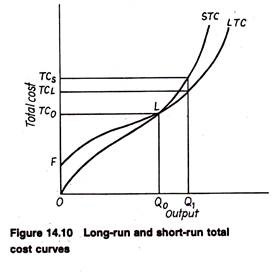In this article we will discuss about the relation between Short-Run and Long-Run Costs.
There is a close relation between short-run and long-run costs. To discover the relation we have to note at the outset that, as a general rule, a business firm plan in the long run and produces in the short run. In other words, the long run is treated as the planning period and the short run as the production period.
Since all inputs are variable, the long-run cost function gives the most efficient (the least cost) method of producing any specified level of output. But once a firm chooses a particular plant size (having fixed production capacity) and starts producing, its options are lost. Hence, it is in the short run. Plant and equipment have already been constructed.
Now if the firm wishes to change its level of output, it cannot vary the quantity of all inputs. The plant size, in particular, remains fixed. Since it is not possible to vary all inputs optimally, the firm cannot produce this new level of output at the minimum cost.
ADVERTISEMENTS:
Such a situation is depicted in Fig. 14.10, where LTC is the firm’s long-run total cost curve. Let us suppose that, when making its plans, the firm had decided that it wanted to produce Q0 units of output per period of time.
It chooses the optimal combination of inputs to produce this output at the minimum possible cost, which is shown as TC0 in Fig. 14.10. Since there is no need to vary any of its inputs so long as it continues to produce Q0, the short-run cost of producing Q0 is the same as the long-run cost.
Thus the short-run total cost curve, STC, is tangent to LTC at point L which corresponds to a level of output Q0 .But since some inputs are fixed in the short run, if the firm wishes to vary its output in the short run, it cannot produce any other level of output at minimum cost.
ADVERTISEMENTS:
In other words, for any level of output except Q0, the short-run input combination is less efficient, i.e., would result in a higher cost than any long-run combination (because in the long run all inputs are variable). Costs are usually higher in the short run than in the long run because business firms have to make certain hasty adjustments in the short run.
Differently put, costs per unit will be less in the long run because the firm can make more flexible adjustments. Let us suppose, for instance, that the firm is desirous of increasing its output from Q0 to Q1. Since all inputs are variable, it could produce this new output at TCL.
But, if the plant size and some other inputs are fixed, STC gives the cost of producing Q1. This cost is TCs which is higher than TCL. The fixed cost is F and the variable cost is TCS -F. Clearly, from Fig. 14.10, STC is greater than LTC at any output other than Q0, since only at output Q0, are the two curves equal.
The relation between LTC and STC determines the relation between the long-run and short-run average cost curves. In Fig. 14.10, short-run average cost is equal to long-run average cost only at an output of Q0, because STC = LTC. Therefore, STC/Q = LTC/Q = or SAC = LAC. At all other levels of output STC > LTC and, therefore, STC /Q ˃ LTC/Q or SAC > LAC.
